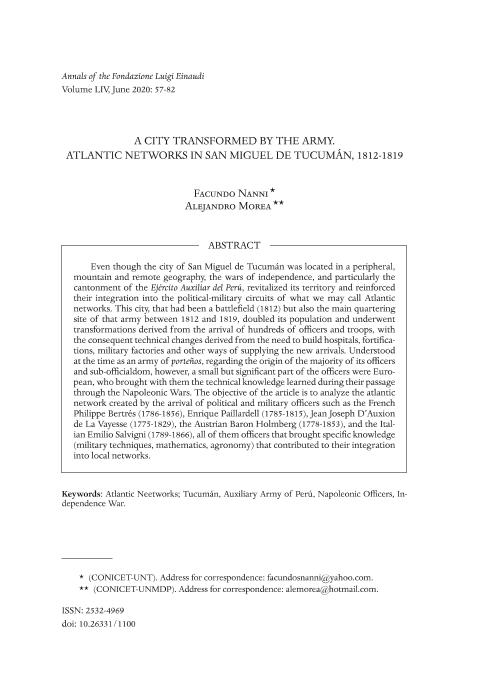Mostrar el registro sencillo del ítem
dc.contributor.author
Nanni, Facundo

dc.contributor.author
Morea, Alejandro Hernán

dc.date.available
2021-10-22T10:57:34Z
dc.date.issued
2020-01
dc.identifier.citation
Nanni, Facundo; Morea, Alejandro Hernán; A city transformed by the army. Atlantic networks in the Ejército Auxiliar del Perú during its quartering in San Miguel de Tucumán: 1812-1819; Olschki; Annals of the Fondazione Luigi Einaudi; XVI; 1-2020; 57-82
dc.identifier.issn
2532-4969
dc.identifier.uri
http://hdl.handle.net/11336/144707
dc.description.abstract
Even though the city of San Miguel de Tucumán was located in a peripheral, mountain and remote geography, the wars of independence, and particularly the cantonment of the Ejército Auxiliar del Perú, revitalized its territory and reinforced their integration into the political-military circuits of what we may call Atlantic networks. This city, that had been a battlefield (1812) but also the main quartering site of that army between 1812 and 1819, doubled its population and underwent transformations derived from the arrival of hundreds of officers and troops, with the consequent technical changes derived from the need to build hospitals, fortifica- tions, military factories and other ways of supplying the new arrivals. Understood at the time as an army of porteños, regarding the origin of the majority of its officers and sub-officialdom, however, a small but significant part of the officers were Euro- pean, who brought with them the technical knowledge learned during their passage through the Napoleonic Wars. The objective of the article is to analyze the atlantic network created by the arrival of political and military officers such as the French Philippe Bertrés (1786-1856), Enrique Paillardell (1785-1815), Jean Joseph D?Auxion de La Vayesse (1775-1829), the Austrian Baron Holmberg (1778-1853), and the Ital- ian Emilio Salvigni (1789-1866), all of them officers that brought specific knowledge (military techniques, mathematics, agronomy) that contributed to their integration into local networks.
dc.format
application/pdf
dc.language.iso
eng
dc.publisher
Olschki
dc.rights
info:eu-repo/semantics/openAccess
dc.rights.uri
https://creativecommons.org/licenses/by-nc-sa/2.5/ar/
dc.subject
ATLANTIC NETWORKS
dc.subject
NAPOLEONIC OFFICERS
dc.subject
EJÉRCITO AUXILIAR DEL PERÚ
dc.subject
TUCUMÁN
dc.subject.classification
Otras Historia y Arqueología

dc.subject.classification
Historia y Arqueología

dc.subject.classification
HUMANIDADES

dc.title
A city transformed by the army. Atlantic networks in the Ejército Auxiliar del Perú during its quartering in San Miguel de Tucumán: 1812-1819
dc.type
info:eu-repo/semantics/article
dc.type
info:ar-repo/semantics/artículo
dc.type
info:eu-repo/semantics/publishedVersion
dc.date.updated
2021-09-06T18:16:27Z
dc.journal.volume
XVI
dc.journal.pagination
57-82
dc.journal.pais
Italia

dc.journal.ciudad
Torino
dc.description.fil
Fil: Nanni, Facundo. Universidad Nacional de Tucumán. Facultad de Filosofía y Letras. Instituto de Investigaciones Históricas "Dr. Ramón Leoni Pinto"; Argentina. Consejo Nacional de Investigaciones Científicas y Técnicas; Argentina
dc.description.fil
Fil: Morea, Alejandro Hernán. Consejo Nacional de Investigaciones Científicas y Técnicas. Centro Científico Tecnológico Conicet - Mar del Plata. Instituto de Humanidades y Ciencias Sociales. Universidad Nacional de Mar del Plata. Instituto de Humanidades y Ciencias Sociales; Argentina
dc.journal.title
Annals of the Fondazione Luigi Einaudi
dc.relation.alternativeid
info:eu-repo/semantics/altIdentifier/doi/http://dx.doi.org/10.26331/1100
Archivos asociados
